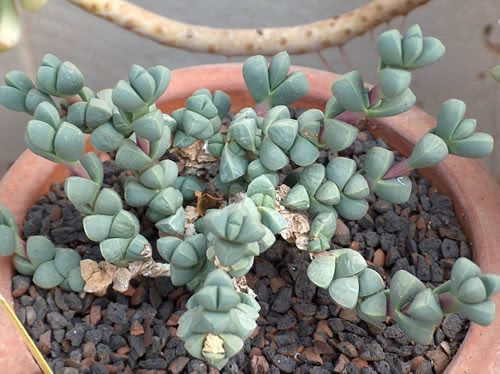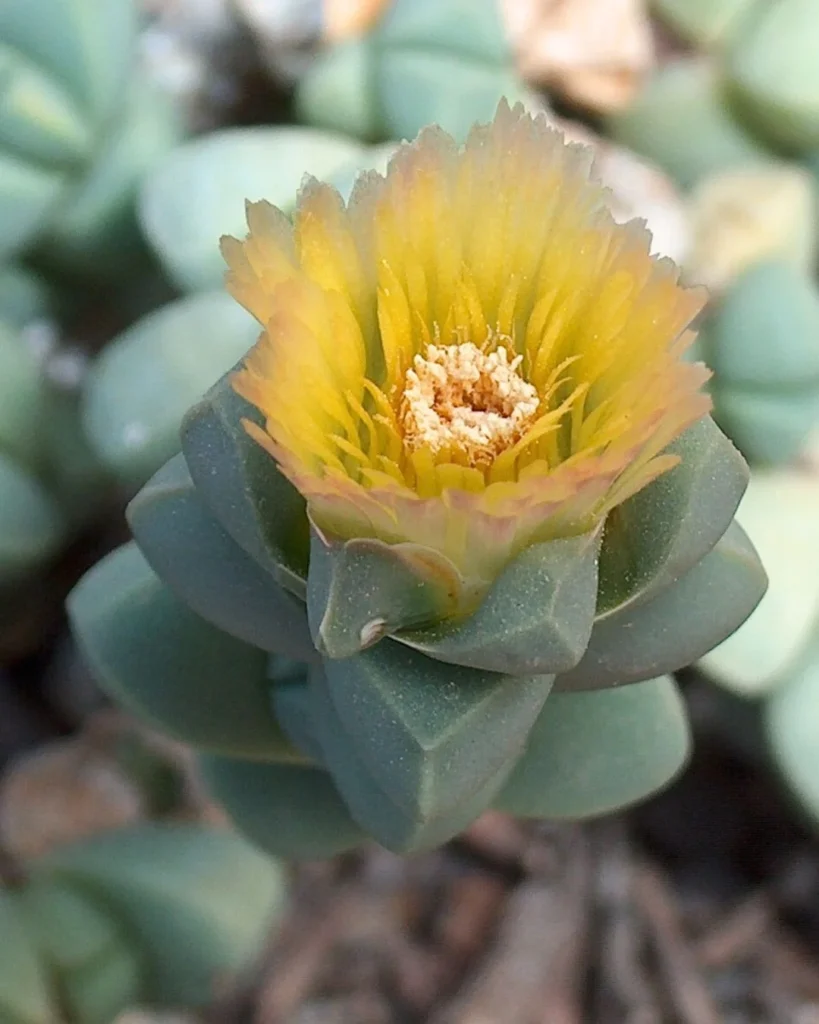The Ice Plant (Corpuscularia lehmannii) is a species of great ornamental value, which has been very successful in terrariums and mini gardens. Native to South Africa, on the African continent, where it grows in semi-arid regions of subtropical climate, this perennial plant stands out for its beauty. The genus name Corpusculari derives from the Latin ‘corpusculum‘, meaning ‘small body’, a direct reference to the compact shape of its leaves. Furthermore, the specific epithet lehmannii was named in honor of the German botanist Johann Georg Christian Lehmann (1792 – 1860), founder of the Hamburg botanical garden, recognizing his contribution.

Its leaves are small, thick, and well-symmetrical, with a rounded pyramid shape (or ice cubs), displaying a bluish-gray coloration. This symmetry adds a unique value to the plant, as does the arrangement in pairs of leaves that resemble a broken heart. During summer and autumn, the plant blooms, displaying yellow inflorescences similar to small daisies, a spectacle in its own right. Interestingly, there is a variegated form of the plant, with leaves mixed with yellow, offering even more options for decoration and collection.
Moreover, the ice plant can be grown in outdoor areas, whether directly in the garden or on patios, balconies, terraces, etc., or indoors, as long as they receive at least 4 hours of direct sunlight. Outdoors, it can behave as a beautiful ground cover, although it is not resistant to trampling. On the other hand, while it is possible to grow it in shaded environments, in such conditions the plant tends to become etiolated, showing greater spacing between the pairs that form the charming broken heart.
This species is ideal for cultivation in pots, rock gardens, terrariums, and mini gardens, due to its small and compact size. The delicate and geometric appearance of the leaves can – and should – be explored to compose a garden of different textures. However, care must be taken when composing terrariums with the ice plant. Many people end up using pots and glasses without holes, or even worse, closed, which is quite dangerous for succulents in general.

Therefore, for more long-lasting arrangements, prefer building mini-gardens or terrariums using properly holed and open containers, for perfect drainage and air circulation. The maintenance of the plant involves replanting, to ensure the health of the roots, preventing rot, and renewing the substrate that can compact over time.
The Corpuscularia lehmannii should be grown under full sun or partial shade. Adaptable to arid and semi-arid conditions, it easily develops in sandy or rocky soils. When cultivating it in pots, it is essential to use substrates specific for succulents, which are well-draining and poor in organic matter. Moreover, this species tolerates long periods of drought. Therefore, watering should be spaced out, ideally watering when the soil is dry and prioritizing perfect drainage to avoid the risk of waterlogging and, consequently, root rot.
On the other hand, regarding fertilization, like other succulents, it should not be intense. It is recommended to fertilize in a balanced way, using ⅓ of the fertilization recommended for other garden plants, or follow the manufacturer’s recommendation if using a fertilizer specific for succulents. Specifically for this species, fertilization should occur during the vegetative period, in spring and summer. Although it is a slow-growing species, when planted directly in the ground, the \emph{Corpuscularia lehmannii} can spread easily, resembling a carpet. Its propagation can be done through leaf or branch cuttings, division of clumps, or by seeds, with propagation by cuttings being the most guaranteed, quick, and easy method to perform.



